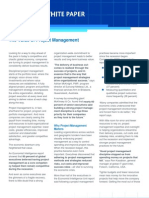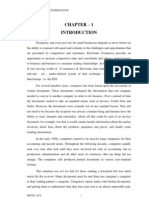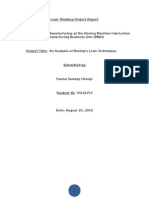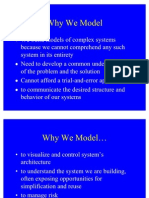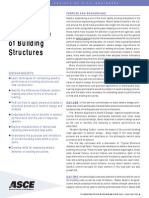Why IT Projects Fail
Why IT Projects Fail
Uploaded by
Basit Javed MalikCopyright:
Available Formats
Why IT Projects Fail
Why IT Projects Fail
Uploaded by
Basit Javed MalikOriginal Description:
Copyright
Available Formats
Share this document
Did you find this document useful?
Is this content inappropriate?
Copyright:
Available Formats
Why IT Projects Fail
Why IT Projects Fail
Uploaded by
Basit Javed MalikCopyright:
Available Formats
ITAudit
BY SAM KHAN EDITED BY STEVE MAR
WHY IT PROJECTS FAIL
By understanding
three key elements,
internal audit can
T
help improve the
success rate of echnology plays a used, while others fall short objectives (Standard 2110:
vital role in any orga- of achieving the original Governance). IT governance
technology initiatives.
nization’s strategic business intent. Despite this should address the progress
initiatives, yet every high failure rate, some orga- and decision-making of proj-
year countless initiatives fail nizations have found ways ects. At Volkswagen, gover-
to deliver value. Take Cover to deliver more projects on nance failed at the highest
Oregon, a $305 million time, on budget, and with levels, while there was no
health insurance exchange better outcomes. The Proj- single point of authority
website intended to help ect Management Institute’s overseeing its development
people find, and sign up (PMI’s) 2018 Pulse of the at Cover Oregon. These
for, health coverage. When Profession report calls these findings resonate with PMI
it failed in 2014, the state organizations champions research reports that show
resorted to paper forms and because of their 92 percent that an actively engaged
hired hundreds of workers to average success rate. Internal executive sponsor is a lead-
enroll people manually. auditors can learn from both ing factor in project success.
Such failure is not lim- the failures and successes of
ited to business applications. these organizations. Measuring Progress Proj-
Today, a new car has more ects do not fail overnight,
lines of code than Microsoft Governance but employees often do not
Office, and project failure can Governance is about mak- accurately report project
lead to death or, in the case of ing good decisions. Many status information or speak
Volkswagen, fraud. The com- organizations have an IT up when they see problems,
pany’s diesel emissions scan- governance function, which a Spring 2014 MIT Sloan
dal has cost it $30 billion. provides a formal structure Management Review article
Over the past two for aligning IT strategy asserts. According to “The
decades, about 70 percent with business strategy. The Pitfalls of Project Status
of IT projects have failed, International Standards for Reporting,” when employees
according to the Standish the Professional Practice of see negative outcomes for
Group, a Boston-based firm Internal Auditing requires others who have delivered
that researches software internal auditors to make bad news, they may fear that
development project perfor- sure IT governance sustains executives will “shoot the
mance. Some of these proj- and supports the orga- messenger.” Such was the
ects are canceled and never nization’s strategies and case at Volkswagen. Rather
SEND ITAUDIT ARTICLE IDEAS to Steve Mar at steve_mar2003@msn.com
16 INTERNAL AUDITOR APRIL 2018
TO COMMENT on this article,
EMAIL the author at sam.khan@theiia.org
than telling management that the engineers could not meet from using four vendors and numerous specification changes
the emission standards, they modified the software to manip- led to failure.
ulate the results, according to a whistleblower’s account. The most effective way to reduce complexity is to limit
Successful organizations do not hide problems. They the size of the project, the Standish Group advises. Based on
have a culture that encourages people to bring problems into evaluating more than 50,000 IT projects, the firm’s research-
the open where they are solved quickly. Internal auditors ers found that a small project, consisting of six team mem-
should assess the culture around project reporting to ensure it bers and completed in six months or less, works best. The
is transparent and honest. firm recommends turning large projects into a series of small
ones, which can dramatically increase the chances of success.
Decisions A $10 million IT project will have approximately Research from the Boston Consulting Group aligns with
15,000 decisions, the Standish Group estimates. With each these findings. The firm has developed an online tool called
bad decision, the odds of success diminish. Yet, the most criti- DICE that internal auditors and organizations can use to
cal decision is whether to start the project at all. For Cover assess the readiness of a project based on four elements:
Oregon, this first decision could have changed the outcome of ɅɅ Duration, or the interval between the project’s major
the project. The organization opted to develop a web applica- “learning milestones” if it lasts six months or longer.
tion from scratch when an existing solution was available. ɅɅ Performance integrity of the project team. This element
Internal auditors should review the criteria organizations encompasses both the overall skills and traits of the
use for evaluating, selecting, prioritizing, and funding IT team, and how the team has been configured.
investments. Decision-makers need an accurate picture of the ɅɅ Commitment to change shown by the senior manage-
resources needed for each proposed project, but estimating ment and the people actually undergoing the change.
these resources is difficult. People tend to be overly optimis- ɅɅ Additional local effort above normal working require-
tic. This is known as the planning fallacy, which can lead to ments that is needed during implementation of those
time overruns, cost overruns, and benefit shortfalls. undergoing the change, as opposed to the project team.
Internal auditors should counteract the planning fallacy
with a stress test. Research from Bent Flyvbjerg and Alex- Lessons Learned
ander Budzier, published in the September 2011 Harvard Although lessons learned are an important part of the project
Business Review, found that one in six of the nearly 1,500 management life cycle, it often is the most ignored part of a
IT projects they studied had a 200 percent cost overrun project. Organizations with poor success rates do not have
and almost 70 percent had a schedule overrun. Based on a good process for identifying and applying lessons to new
this data, they devised a stress test. An organization should projects. Many organizations have not established a repository
proceed with a large IT project only if it can absorb a budget for sharing knowledge across the business. As a result, valuable
overrun of 400 percent and is comfortable only achieving knowledge can be lost or forgotten and projects continue to
25 percent to 50 percent of the projected benefits. fail for the same reasons. Internal auditors can review whether
the organization has a culture of learning from mistakes and
Complexity how it shares and applies that knowledge to future projects.
Organizations also should consider ways to reduce the proj-
ect’s complexity. Technology is rarely the cause of project fail- Improving Success Chances
ure. It is the complexity of other factors that lead to failure. Despite the high risk of IT project failure, internal auditors
When planning any change initiative, the organization needs can help their organization beat the odds by reviewing the
to consider the impact the project may have on the existing governance, complexity, and lessons learned from projects.
organizational culture, the training resources needed, the Specifically, they should evaluate the risks related to large
effect of new regulations, changes to the business environ- technology projects and perform health checks during key
ment, the effort to change business processes, and how the project milestones defined in the project plan. Moreover,
organization will manage vendor relationships. they should benchmark the organization’s current project
Often, these factors fall prey to the planning fallacy, success rate against the PMI Pulse of the Profession. A future
which can quickly increase the complexity of a large IT proj- of more successful technology initiatives starts with improved
ect and reduce the chances of meeting the original business controls today.
intent. An example is the 2013 U.K. National Health Service
System, which overran costs by £11 billion ($15.3 billion) SAM KHAN, CISA, CRISC, is senior IT auditor at Oregon State
and was delivered nine years late. The complexity resulting University in Corvallis.
APRIL 2018 INTERNAL AUDITOR 17
You might also like
- Platinum Secrets (1) - 221223 - 121602Document23 pagesPlatinum Secrets (1) - 221223 - 121602keloke kfue100% (4)
- W. Brian Arthur-Complexity and The Economy-Oxford University Press (2014) PDFDocument241 pagesW. Brian Arthur-Complexity and The Economy-Oxford University Press (2014) PDFbilly jimenez100% (2)
- "If Only HP Knew What HP Knows": The Roots of Knowledge Management at Hewlett-PackardDocument7 pages"If Only HP Knew What HP Knows": The Roots of Knowledge Management at Hewlett-Packardhamidnazary2002No ratings yet
- Case Study: Selecting A Trade BankerDocument5 pagesCase Study: Selecting A Trade BankerMohit SahajpalNo ratings yet
- The Product Development and Commercialization ProcDocument2 pagesThe Product Development and Commercialization ProcAlexandra LicaNo ratings yet
- Practical Steps To Smooth Separation For Employees and Human ResourcesDocument13 pagesPractical Steps To Smooth Separation For Employees and Human Resourcesvikas@davim100% (1)
- Understanding The Role of Politics in Successful Project ManagementDocument7 pagesUnderstanding The Role of Politics in Successful Project Managementapi-3707091100% (10)
- InterGen and Quezon CaseDocument2 pagesInterGen and Quezon CaseVasanth SubramanyamNo ratings yet
- Business Relationship Management A Complete Guide - 2021 EditionFrom EverandBusiness Relationship Management A Complete Guide - 2021 EditionNo ratings yet
- Essay Plan - Do Political Connections Constitute A Competitive Advantage'Document9 pagesEssay Plan - Do Political Connections Constitute A Competitive Advantage'esthernkwNo ratings yet
- History and Myth in Romanian ConsciousnessDocument295 pagesHistory and Myth in Romanian Consciousnesstutor79100% (9)
- Factors That Influence Consumer Purchasing Decisions of Private Label Food ProductsDocument92 pagesFactors That Influence Consumer Purchasing Decisions of Private Label Food ProductsAlexandra-Elena Oprea100% (1)
- 7458-PM Putting The Pieces TogetherDocument11 pages7458-PM Putting The Pieces Togethermello06No ratings yet
- Global IT Project Management Survey 0508Document40 pagesGlobal IT Project Management Survey 0508surnj1No ratings yet
- The Value of Project ManagementDocument6 pagesThe Value of Project ManagementRolly SocorroNo ratings yet
- 12.2 Sourcing Implementation & Administration Guide PDFDocument246 pages12.2 Sourcing Implementation & Administration Guide PDFJose GuillénNo ratings yet
- Touching Lives, Improving Life . Procter & GambleDocument20 pagesTouching Lives, Improving Life . Procter & GambleHanan NathekarNo ratings yet
- Understanding The Strategic Value Ofitinm&A: January 2011Document6 pagesUnderstanding The Strategic Value Ofitinm&A: January 2011shreejit96837No ratings yet
- post merger integration courses A Complete Guide - 2019 EditionFrom Everandpost merger integration courses A Complete Guide - 2019 EditionNo ratings yet
- Samsung Balanced ScorecardDocument3 pagesSamsung Balanced ScorecardShabana Khan0% (1)
- LeanIX M&a Survey 2021 enDocument11 pagesLeanIX M&a Survey 2021 enGene RodriguezNo ratings yet
- Sales & Distribution ManagementDocument36 pagesSales & Distribution Managementmba betaNo ratings yet
- BCG The Comeback Kids Nov 2017 Tcm9 175991Document39 pagesBCG The Comeback Kids Nov 2017 Tcm9 175991Thanh Trung NguyenNo ratings yet
- Factory Mode Vs Studio Mode Case Study-1Document5 pagesFactory Mode Vs Studio Mode Case Study-1Christo DunstonNo ratings yet
- Chapter 4Document34 pagesChapter 4abbasamir2998100% (1)
- 5 Reasons Projects FailDocument16 pages5 Reasons Projects Failmuralimohanrao rojukurthi100% (1)
- BUS3103 Assessment 3 Market Entry Report 201620Document6 pagesBUS3103 Assessment 3 Market Entry Report 201620Shoaib AhmedNo ratings yet
- Agile Project Management and Project Success A Literature ReviewDocument10 pagesAgile Project Management and Project Success A Literature ReviewnouraNo ratings yet
- Deloitte Uk Finance Business PartneringDocument16 pagesDeloitte Uk Finance Business PartneringrubenrealperezNo ratings yet
- Assignment Brief Brand ManagementDocument2 pagesAssignment Brief Brand Managementabeera100% (1)
- PWC Strategy & PlanningDocument3 pagesPWC Strategy & Planningammar aliNo ratings yet
- PWC Ifrs Ifrs9 New Way Hedging StrategiesDocument2 pagesPWC Ifrs Ifrs9 New Way Hedging StrategiesfabiopnoronhaNo ratings yet
- The Diamond FrameworkDocument45 pagesThe Diamond FrameworkMaria Tariq100% (1)
- AT Kearney ERP MythsDocument11 pagesAT Kearney ERP MythsSamirNo ratings yet
- MBA Strategic Management PresentationDocument10 pagesMBA Strategic Management PresentationAneesh Thankachan100% (1)
- EY CAFTA Case StudyDocument8 pagesEY CAFTA Case StudyPratul PrakharNo ratings yet
- Gaps Model in Commercial Real EstateDocument30 pagesGaps Model in Commercial Real EstateSiddharth Singh TomarNo ratings yet
- FAA Notice of Proposed Civil PenaltyDocument3 pagesFAA Notice of Proposed Civil PenaltyDavid SlotnickNo ratings yet
- CustomerThink Top 5 Practices of CX Winners PDFDocument12 pagesCustomerThink Top 5 Practices of CX Winners PDFUdit Agarwal100% (1)
- SWOT Analysis of BlockchainDocument21 pagesSWOT Analysis of BlockchainrofirheinNo ratings yet
- People Make DifferenceDocument14 pagesPeople Make Differencetansil nazNo ratings yet
- Saskatchewan Provincial Park CaseDocument2 pagesSaskatchewan Provincial Park CaseMohamad BachoNo ratings yet
- Electronic Data InterchangeDocument35 pagesElectronic Data Interchangesameer7mohammad100% (1)
- C11SH+Pre Released+Case+Study+MaterialDocument4 pagesC11SH+Pre Released+Case+Study+MaterialAfshan NazirNo ratings yet
- The Wallace GroupDocument2 pagesThe Wallace GroupRoselyn Pama100% (1)
- Lean Thinking Full Project ReportDocument6 pagesLean Thinking Full Project ReportSunday FasinaNo ratings yet
- Financial Cash Flow Determinants of Company Failure in The Construction Industry (PDFDrive) PDFDocument222 pagesFinancial Cash Flow Determinants of Company Failure in The Construction Industry (PDFDrive) PDFAnonymous 94TBTBRksNo ratings yet
- SKU OptimizationDocument46 pagesSKU Optimizationsmh9662No ratings yet
- BP Amoco Pre Zen Tare PPT ModificatDocument37 pagesBP Amoco Pre Zen Tare PPT ModificatSergiu DraganNo ratings yet
- Bus 5611 Wa Unit 1Document3 pagesBus 5611 Wa Unit 1Hassan Suleiman SamsonNo ratings yet
- SBUDocument11 pagesSBUVishal TomarNo ratings yet
- MNG3701 Assessment 2 2023Document7 pagesMNG3701 Assessment 2 2023Zandile NgcoboNo ratings yet
- Guide To Building A Great Startup Board - PaperDocument13 pagesGuide To Building A Great Startup Board - PapersvdNo ratings yet
- Mro Assignmen1Document11 pagesMro Assignmen1Fatima RazaNo ratings yet
- NMIMS M & A Presentation.1Document58 pagesNMIMS M & A Presentation.1Pratik KamaniNo ratings yet
- 269 Assignment ReviewdDocument18 pages269 Assignment ReviewdHasan MahmoodNo ratings yet
- Annual Report Wirecard 2018Document245 pagesAnnual Report Wirecard 2018Blanche RyNo ratings yet
- 1 Opening Case Anne Mulcahy at XeroxDocument1 page1 Opening Case Anne Mulcahy at XeroxmmmsaNo ratings yet
- Lecture 22Document14 pagesLecture 22lc_surjeetNo ratings yet
- MBA 5002 - Assessment GuideDocument12 pagesMBA 5002 - Assessment GuideMohamed NaieemNo ratings yet
- People in Organization CH5Document10 pagesPeople in Organization CH5Ayus DioNo ratings yet
- Baluyot - Activity #2 - EthicsDocument2 pagesBaluyot - Activity #2 - EthicsDani CastroNo ratings yet
- Team Scoring Systems and Swiss Chess TournamentsDocument9 pagesTeam Scoring Systems and Swiss Chess Tournamentsvenkatachalam.jNo ratings yet
- Ars Quatuor Coronatorum Volume 01Document280 pagesArs Quatuor Coronatorum Volume 01aqcjm7167% (3)
- Mutazila GrammariansDocument6 pagesMutazila GrammariansTsanarNo ratings yet
- Er ModelingDocument92 pagesEr ModelingRuchika MahajanNo ratings yet
- NotesDocument117 pagesNoteslameliagomba9No ratings yet
- ProposalFinal 2Document17 pagesProposalFinal 2Amany HassanNo ratings yet
- Aldous Huxley Between The Wars - Essays and Letters. - Free Online LibraryDocument4 pagesAldous Huxley Between The Wars - Essays and Letters. - Free Online LibraryHasan ArslanNo ratings yet
- The Reincarnation TrapDocument5 pagesThe Reincarnation TrapRob Zel100% (2)
- 2A Ingles EinsteinsTheoryEXAMENDocument1 page2A Ingles EinsteinsTheoryEXAMENMercader YMartínez ConsultoresNo ratings yet
- Principles of TranslationDocument20 pagesPrinciples of TranslationSaeedHANo ratings yet
- Seismic Design and Performance of Building StructuresDocument2 pagesSeismic Design and Performance of Building StructuresHaris ANo ratings yet
- Acqua HFDocument377 pagesAcqua HFVictor Iduh AttahNo ratings yet
- Ferriols InsightDocument4 pagesFerriols InsightAmi TyNo ratings yet
- Translation and Postcolonial IdentityDocument20 pagesTranslation and Postcolonial IdentityannacvianaNo ratings yet
- Heartfulness Magazine - January 2019 (Volume 4, Issue 1)Document84 pagesHeartfulness Magazine - January 2019 (Volume 4, Issue 1)HeartfulnessNo ratings yet
- LoveDocument2 pagesLoveDaniel Keeran MSWNo ratings yet
- Freud's Mental Path To Profits PDFDocument4 pagesFreud's Mental Path To Profits PDFcepolNo ratings yet
- Ramadhan10 160514141049Document7 pagesRamadhan10 160514141049zahidNo ratings yet
- Pilot Induction ProgramDocument9 pagesPilot Induction ProgramSilvia Oana Paulescu100% (1)
- The Nature of CommunicationDocument18 pagesThe Nature of CommunicationJasken MabiniNo ratings yet
- CurriculumVitae JamesFPeters 26aug2015 PDFDocument25 pagesCurriculumVitae JamesFPeters 26aug2015 PDFNabbyNo ratings yet
- 3 Souls Long Journey ChartsDocument20 pages3 Souls Long Journey Chartspieterinpretoria391No ratings yet
- L'Oreal Brand Storm 2012 Pre-Case and Case Study - The Body ShopDocument4 pagesL'Oreal Brand Storm 2012 Pre-Case and Case Study - The Body ShopArsen AbdyldaevNo ratings yet
- Auss20070401 V45 01Document164 pagesAuss20070401 V45 01mateiflorin07No ratings yet
- Vote of ThanksDocument2 pagesVote of ThanksAnkur BhattNo ratings yet














